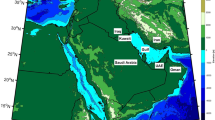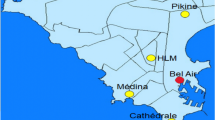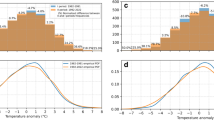Abstract
Meteorological conditions have a decisive impact on surface ozone concentrations. In this study, an empirical model is used to explain the interdependence of ozone and grosswetterlagen. Different meteorological parameters such as air temperature, global solar radiation, relative humidity, wind direction and wind speed are used. Additional nitric oxide (NO) was taken as a representative for the emission situation and ozone maximum of the preceding day in order to evaluate the development of the photochemical situation. The dataset includes data collected over a period of three years (1992–1994) from three stations outside of Munich and one in the center of Munich.
All values become variables by calculating means, sums or maxima of the basic dataset consisting of half-hour means. Seasonal periodicity of data is detected with Fourier analysis and eliminated by a division method after computing a seasonal index.
The dataset is divided into three different grosswetterlagen groups, depending on main wind direction. One mostly cyclonic (westerly winds), onemixed (alternating winds) and one onlyanticyclonic (easterly winds). The last is completed with one summertime group including values from April to August.
Factor analysis is performed for each group to obtain independent linear variable combinations. Overall, relative humidity is the dominant parameter, a typical value indicating meteorological conditions during a grosswetterlage.
Linear multiple regression analysis is performed using the factors obtained to reveal how the ozone concentrations are explained in terms of meteorological parameters and NO. The results improve from cyclonic to anticyclonic grosswetterlagen in conformance with the increasing significance of photochemistry, indicated by the high solar radiation and high temperature, and the low relative humidity and low wind speed. The explained variance r2 reaches its maximum with more than 50 % of the time in Munich center.
This empirical model is applicable to the forecasting of local ozone maximum concentrations with a total standard error deviation of 8.5 to 12.8 % and, if ozone concentrations exceed 80 ppb, with a standard error deviation of 5.4 to 9.5 %.
Similar content being viewed by others
References
Aron, R. H.;I. Aron: Statistical Forecasting Models: II. Oxidant Concentrations in the Los Angeles Basin. Journal of the Air Pollution Control Association, Vol. 28, No. 7, pp. 684–688 (1978)
Backhaus, K.;B. Erichson;W. Plinke;C. Schuchard-Ficher;R. Weiber: Multivariate Analysemethoden. Eine anwendungsorientierte Einführung 4. neu bearb. u. erw. Aufl., Springer, Berlin u.a. (1987)
Bahrenberg, G.;E. Giese;J. Nipper: Statistische Methoden in der Geographie. Bd.2: Multivariate Statistik. 2. Aufl., Teubner, Stuttgart (1992)
Beilke, S.: Meteorologische Voraussetzungen für die Bildung von Ozon und Sommersmog. Ozon-Symposium in München 2.–4. Juli 1991 veranstaltet vom Bundesministerium für Umwelt, Naturschutz und Reaktorsicherheit und Bayerischen Staatsministerium für Landesentwicklung und Umweltfragen, TÜV-Akademie Bayern/Hessen u.a., München (1991)
Bigler-Engler, V.;H. W. Brown: Analysis of an Ozone Episode during the San Diego Air Quality Study: The Significance of Transport Aloft. Journal of Applied Meteorology, Vol. 34, No. 8, pp. 1863–1876 (1995)
Böllmann, U.: Veröffentlichung von Ozonmeßdaten und ausgewählte Ozonprognosemodelle. Bericht zur Informationsveranstaltung „Ozon in Bayern“, Wackersdorf, S. 7–40 (1995)
Bruckmann, P.;E. W. Langensiepen: Untersuchungen über Zusammenhänge zwischen Ozonkonzentration und meteorologischen Parametern im Rhein-Ruhr-Gebiet. Staub, Reinhaltung der Luft, Bd. 41, H. 3, S. 79–85 (1981)
Burrows, W. R.;M. Benjamin;S. Beauchamp;E. R. Lord;D. Collor;B. Thomson: CART Decision-Tree Statistical Analysis and Prediction of Summer Season Maximum Surface Ozone for the Vancouver, Montreal, and Atlantic Regions of Canada. Journal of Applied Meteorology, Vol. 34, No. 8, pp. 1848–1862 (1995)
Chock, D. P.: Issues Regarding the Ozone Air Quality Standards. Journal of the Air and Waste Management Association, Vol. 41, pp. 148–152 (1991)
Clark, T. L.;T. R. Karl: Application of Prognostic Meteorological Variables to Forecasts of Daily Maximum One-Hour Ozone Concentrations in the Northeastern United States. Journal of Applied Meteorology, Vol. 21, No. 11, pp. 1662–1671 (1982)
Comrie, A. C.: The Climatology of Surface Ozone in Rural Areas. A Conceptual Model. Progress in Physical Geography, Vol. 14, No. 3, pp. 295–316 (1990)
Comrie, A. C.: An Enhanced Synoptic Climatology of Ozone Using a Sequenzing Technique in: Physical Geography, Vol. 13, No. 1, pp. 53–65 (1992)
Cvitas, T.;H. Güsten;L. Klasinc: Statistical Association of the Photochemical Ozone Concentrations in the Lower Atmosphere of Zagreb with Meteorological Variables. Staub, Reinhaltung der Luft, Bd. 39, H. 3, pp. 92–95 (1979)
Dye ,T. S.;P. T. Roberts, M. E. Korc: Observations of Transport Processes for Ozone and Ozone Precursors during the 1991 Lake Michigan Ozone Study. Journal of Applied Meteorology, Vol. 34, No. 8, pp. 1877–1889 (1995)
Eder, B. K.;J. M. Davis, P. Bloomfield: An Automated Classification Scheme Designed to Better Elucidate the Dependence of Ozone on Meteorology. Journal of Applied Meteorology, Vol. 33, No., pp. 1182–1199 (1994)
Fabian, P.;C. Haustein;G. Jakobi;B. Rappenglück;P. Suppan;P. Steil: Photochemical Smog in the Munich Metropolitan Area. Contributions to Atmospheric Physics, Vol. 67, No. 1, pp. 39–56 (1994)
Fabian, P.;P.G. Pruchniewicz: Meridional Distribution of Ozone in the Troposphere and its Seasonal Variations. Journal of Geophysical Research, Vol. 82, No. 15, pp. 2063–2073 (1977)
Feister, U.;K. Balzer: Surface Ozone and Meteorological Predictors on a Subregional Scale. Atmospheric Environment, Vol. 25 A, No. 9, pp. 1781–1790 (1991)
Fishman, J.;P. J. Crutzen: The Origin of Ozone in the Troposphere. Nature, Vol. 274, No. 8, pp. 855–858 (1978)
Fricke, W.;B. Schreiber: Darstellung von Zusammenhängen zwischen Ozon und Großwetterlagen mit Hilfe von Boxplots. Berichte des Instituts für Meteorologie und Geophysik der Universität Frankfurt am Main, Nr. 80, Prof. Hans-Walter Georgii zum 65. Geburtstag., Frankfurt am Main (1989)
Guichert, R.;H. van Dop: Photochemical Production of Ozone in Western Europe (1971–1975) and its Relation to Meteorology. Atmospheric Environment, Vol. 11, No. 2, pp. 145–155 (1977)
Haustein von Haustenau, C.: Messungen verkehrsbedingter Luftschadstoffe im Raum München. Meteorologisches Institut, Universität München, Wissenschaftliche Mitteilungen, Nr. 65 (1993)
Hess, P.; H. Brezowsky: Katalog der Großwetterlagen Europas. 2. neu bearb. u. erg. Aufl., Offenbach am Main (1969) (Berichte des Deutschen Wetterdienstes, Nr. 113)
Kahler, W.: SPSS für Windows Datenanalyse unter Windows. 2. Auflage, Vieweg, Braunschweig (1994)
Kelly, N. A.;M. A. Ferman;G. T. Wolff: The Chemical and Meteorological Conditions Associated with High and Low Ozone Concentrations in Southeastern Michigan and Nearby Areas of Ontario. Journal of the Air Pollution Control Association, Vol. 36, No. 2, pp. 150–158 (1986)
Lefohn, A. S.;D. S. Shadwick;U. Feister;V. A. Mohnen: SurfaceLevel Ozone: Climate Change and Evidence for Trends. Journal of the Air and Waste Management Association, Vol. 42, No. 2, pp. 136–144 (1992)
Liu, C;C. Huang;S. Shieh;C. Wu: Important Meteorological Parameters for Ozone Episodes Experienced in the Taipei Basin. Atmospheric Environment, Vol. 28, No. 1, pp. 159–173 (1994)
Marinell, G.: Multivariate Verfahren. Einführung für Studierende und Praktiker. 4. erw. Aufl., Oldenbourg, München u.a. (1995)
Monn, CH.;O. Braendli;G. Schaeppi;CH. Schindler;U. Acker-Mann-Liebrich;PH. Leuenberger: Particular Matter < 10 μm (PM10) and Total Suspended Particulates (TSP) in Urban, Rural and Alpine Air in Swizerland. Atmospheric Environment, Vol. 29, No. 19, pp. 2565–2573 (1995)
Muschalik, B.;H.W. Georgii: Der Einfluß meteorologischer Parameter auf die bodennahe Oxidantienverteilung. Forschungsbericht des Institutes für Meteorologie und Geophysik der Universität Frankfurt am Main im Auftrag des Umweltbundesamtes, Umweltforschungsplan des Bundesministers des Innern, Luftreinhaltung (1980)
Niccum, E. M.;D. E. Lehrman;W. R. Knuth: The Influence of Meteorology on the Air Quality in the San Luis Obispo County — Southwestern San Joaquim Valley Region for 3–6 August 1990. Journal of Applied Meteorology, Vol. 34, No. 8, pp. 1834–1847 (1995)
Pagnotti, V: Seasonal Ozone Levels and Control by Seasonal Meteorology. Journal of the Air and Waste Management Association, Vol. 40, No. 2, pp. 206–210 (1990)
Pryor, S.C.;I.G. McKendry;D.G. Steyn: Synoptic-Scale Meteorological Variability and Surface Ozone Concentrations in Vancouver, British Columbia. Journal of Applied Meteorology, Vol. 34, No. 8, pp. 1824–1833 (1995)
Puxbaum, H.: Bildungswege des bodennahen Ozons. Göch Symposium „Bodennahes Ozon“, 12. und 13. November 1990, Hg. Gesellschaft Österreichischer Chemiker, Riegelnik, Wien (1990) (Schriftenreihe „Umweltschutz“, Bd. 11, S. 5–25)
Revlett, G. H.: Ozone Forecasting Using Empirical Modeling. Journal of the Air Pollution Control Association, Vol. 28, No. 4, pp. 338–343 (1978)
Robeson, S.M.;D.G. Steyn: Evaluation and Comparison of Statistical Forecast Models for Daily Maximum Ozone Concentrations. Atmospheric Environment, Vol. 24 B, No. 2, pp. 303–312 (1990)
Ryan, W. F.: Forecasting Severe Ozone Episodes in the Baltimore Metropolitan Area. Atmospheric Environment, Vol. 29, No. 17, pp. 2387–2398 (1995)
Schmidt, M.;P. Fabian: Relationship between Tropospheric Ozone Concentration and the General Weather Situation. Contribution to Atmospheric Physics, Vol. 53, No. 1, pp. 63–73 (1980)
Spiegel, M. R.: Statistik. 2. überarb. u. erw. Aufl., Hauser, München u. McGraw-Hill, Hamburg (1990)
Steil, P.: Ozonkonzentrationen im Stadtgebiet — Charakteristika und Zusammenhänge am Beispiel der LÜB-Station Lothstraße in München. Bayerisches Landesamt für Umweltschutz (Hrsg.), München (1994)
Volz, A.; H. Geiss; S. McKeen; D. Kley: Correlation of Ozone and Solar Radiation at Montsouris and Hohenpeissenberg: Indications for Photochemical Influence. Ozone in the Atmosphere. Procedings of the Quadrennial Ozone Symposium 1988 and Tropospheric Ozone Workshop, Göttingen 4.–13. August 1988. Ed. Bojkov Rumen D., Fabian Peter. Deepak, Hampton, Va. (1989) (Studies in Geophysical Optics and Remote Sensing), pp. 447–450
Vukovich, F. M.: Regional-Scale Boundary Layer Ozone Variations in the Eastern United States and their Association with Meteorological Variations. Atmospheric Environment, Vol. 29, No. 17, pp. 2259–2273 (1995)
Vukovich, F. M.;W. D. JR.Bach;B. W. Crissman;W. J. King: On the Realtionship between High Ozone in the Rural Surface Layer and High Pressure Systems. Atmospheric Environment, Vol. 11, pp. 967–983 (1977)
Vukovich, F. M.;J. Fishman: The Climatology of Summertime O3 and SO2 (1977–1981). Atmospheric Environment, Vol. 20, No. 12, pp. 2423–2433 (1986)
Wolff, G. T.;P. J. Lioy: An Empirical Model for Forecasting Maximum Daily Ozone Levels in the Northeastern U.S. Journal of the Air Pollution Control Association, Vol. 28, No. 10, pp. 1034–1038 (1978)
Author information
Authors and Affiliations
Rights and permissions
About this article
Cite this article
Spichtinger, N., Winterhalter, M. & Fabian, P. Ozone and grosswetterlagen. Environ. Sci. & Pollut. Res. 3, 145–152 (1996). https://doi.org/10.1007/BF02985522
Issue Date:
DOI: https://doi.org/10.1007/BF02985522




